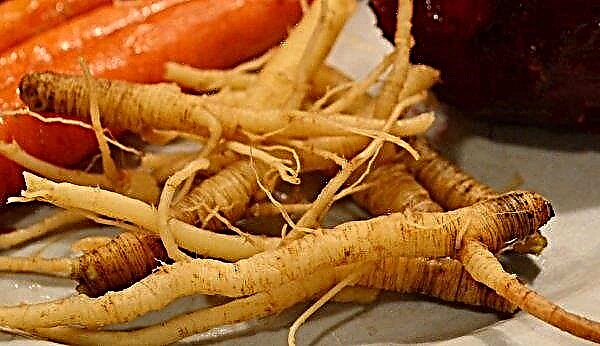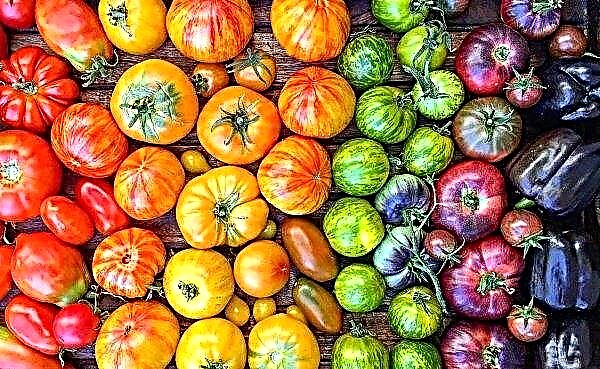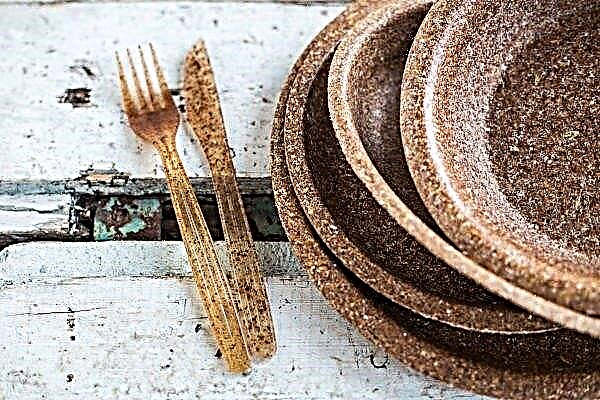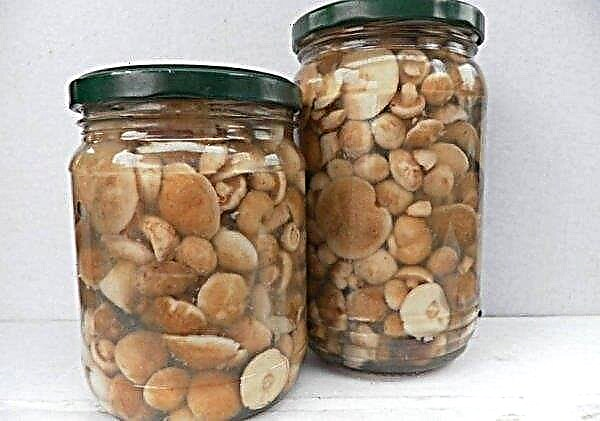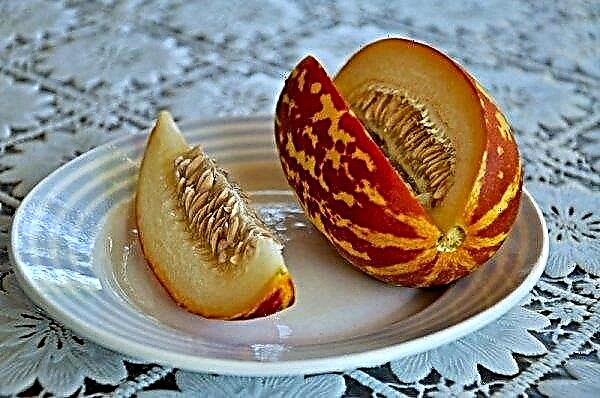Among the many varieties of tomatoes there are many such that with their unique taste and excellent characteristics can surprise not only amateur gardeners, but also experienced professional vegetable growers. This sort of tomato is Pink Cheeks F1.
Did you know? There is a word in Russian «pomdamour» (tomato), which in French means "apple of love."
Description and characteristics of the variety
The fruits of this hybrid are distinguished by their meatiness, juiciness and are so tasty that tasting can surprise even a sophisticated gourmet. To get a high yield and an excellent result, you need to know the rules of care and cultivation, get acquainted with the hallmarks and features of this tomato. F1 pink cheeks are mid-early. The time from sowing seeds to fruit ripening is 110-120 days. A plant is of a determinant type (growth restriction in connection with the laying of flowers at the top), that is, undersized. Growing such tomatoes is convenient, as pruning bushes is almost not required. The growth of the bush is 70–80 cm, in closed ground conditions it can reach 1.5 m with an artificial increase in the height of the bush, which allows to increase productivity. Despite its limitations, it grows well, and can reach a large volume. The leaves are medium sized, light green.
Growing such tomatoes is convenient, as pruning bushes is almost not required. The growth of the bush is 70–80 cm, in closed ground conditions it can reach 1.5 m with an artificial increase in the height of the bush, which allows to increase productivity. Despite its limitations, it grows well, and can reach a large volume. The leaves are medium sized, light green.
The inflorescence is a simple brush, 3-5 large, flat-rounded tomatoes grow on it, which, upon reaching ripeness, acquire a bright raspberry-pink color. Unripe tomatoes have a green color with a dark spot around the stem. The mass of tomato is 200-350 g. The hybrid is recommended for cultivation in greenhouses, as well as in open areas of land.
Did you know? Tomato was known in the mountainous regions of Peru and Mexico as an edible plant as far back as the 5th century BC, and came to Europe only in the 16th century and was used as an exotic decorative planting.
Pink cheeks F1 have the following characteristics:
- the pulp of the fruit is dense, fleshy and juicy;
- tomatoes are basically the same size and size, large;
- peel of medium density and thickness;
- the number of seed chambers - at least 4;
- the first inflorescence is above 6-8 leaves;
- the shape of the fruit is standard - flat-rounded with a slightly pronounced ribbing;
- high taste;
- universality of use (used raw, for salting, canning, making tomato puree and juice).
 The hybrid was developed by specialists of the selection seed company Manul in 2002 (Russia, Moscow Region, Mytishchi). Registered in the State Register of the Russian Federation in 2003, recommended for cultivation in closed ground (also allowed in open areas in the southern regions).
The hybrid was developed by specialists of the selection seed company Manul in 2002 (Russia, Moscow Region, Mytishchi). Registered in the State Register of the Russian Federation in 2003, recommended for cultivation in closed ground (also allowed in open areas in the southern regions).Advantages and disadvantages of the variety
Tomatoes Pink cheeks, having many positive reviews of gardeners, justify their disposition to themselves with characteristic advantages.
- The advantages of tomato include:
- excellent tastes (a balanced amount of acid and sugar, gives tomatoes a special taste and delicate aroma);
- good transportability (during transportation it retains excellent presentation);
- perfectly stored for a long time;
- universality of cultivation (in open ground, in greenhouses);
- high resistance to disease (before the appearance of late blight on the fruit, usually manages to give a good harvest);
- large fruits (weight 200-350 g);
- lack of cracking (when weather conditions change, precipitation preserves the integrity of the fetus);
- good productivity (5-6 kg from 1 m²).
According to reviews of vegetable growers, there are no shortcomings in this variety. To obtain the expected high yield, in their opinion, should be grown in greenhouses, but also in the open field, with the right approach, you can get a stable crop. Tomato grows in open areas, characterized by good productivity and unpretentiousness to growing conditions. Of course, there are certain growing conditions under which the result is achieved.
Features of planting and growing in open ground
Pink cheeks are a heat-loving variety, so you need to take into account the weather conditions in the region where it will grow. Optimum conditions - a lot of light, a moderate amount of moisture, the appropriate temperature. Sowing seeds for further transplanting seedlings into the soil is carried out in the first ten days of March (from the 1st to the 10th day), having previously treated them with manganese and washed with clean water. This provides disease prevention. You can also treat the seeds with a growth stimulant. But it’s better to plant already “hatching” ones. To do this, they are placed in a slightly moistened cloth and placed near the battery or in another warm place for 2-3 days. Then the seeds swell and sprouts appear. When sowing such seed material, seedlings occur faster and in larger quantities. It is better to plant, limiting seedlings, that is, in separate containers, so as not to dive subsequently.
To do this, they are placed in a slightly moistened cloth and placed near the battery or in another warm place for 2-3 days. Then the seeds swell and sprouts appear. When sowing such seed material, seedlings occur faster and in larger quantities. It is better to plant, limiting seedlings, that is, in separate containers, so as not to dive subsequently.
Sow seeds in pots measuring 10 cm by 1 cm, filling them with a nutrient mixture: earth, compost, humus - in equal parts, or using a universal soil mixture for seedlings. Seeds are laid 1 cm deep into the soil and moistened with warm water. More often, tomato seeds are sown in large boxes or containers - it is easier to care for seedlings. Sowing is carried out in furrows to a depth of 1-1.5 cm with a distance between seeds of about 2 cm.
Important! Buy seed only from sellers you trust, or better, in specialized stores from seed manufacturers.
The box is covered with film or glass to create the effect of a greenhouse until emergence. When 1–2 of these leaves appear, dives of seedlings are carried out in separate containers. It is better to transplant by transshipment - carefully, without affecting the young roots, with a lump of earth. 7–9 days after the dive, you need to fertilize the plants with complex fertilizer.
Before planting in open ground, seedlings are in pots for 55-60 days. During this period of time it is necessary to feed it 2-3 times with complex fertilizer, maintain the temperature at the level of +22 ... + 25 ° С, provide good lighting. Watering is carried out as the topsoil is dried. Having grown seedlings, you need to correctly determine the time of planting it in the ground and adhere to the rules of cultivating a vegetable.
Tomato Care
In the open ground, it is necessary to plant a crop when the frosts pass - the end of May, the beginning of June. Previously, a week before, the plants need to be hardened. To begin with, tomatoes are taken out to fresh air for half an hour, gradually increasing the time spent on the street to 3-4 hours. The landing area should be well lit and protected from the wind. Loamy soils are best suited.
Planting seedlings is carried out at a distance of 40-50 cm from each other, the distance between the rows is about 50 cm. It is recommended to plant 4 tomatoes per 1 m². Those who want to get an earlier harvest of tomatoes need to plant them in the first ten days of May and cover with a film until the weather is stable and stable.
Important! An excess of organic fertilizers leads to an increase in green mass in tomatoes and a decrease in the number of ovaries, which significantly reduces the yield.
The main components of pink cheek tomato care are:
- regular watering;
- weeding;
- loosening the soil;
- timely application of mineral fertilizers.
Fertilizer and watering
During the vegetative period, tomato bushes are fed 2-3 times with the help of mineral fertilizers. 14 days after planting, the first fertilizer is applied: mullein solution, as well as a complex mineral composition - ammonium nitrate, potassium chloride, superphosphate. Subsequent dressing is introduced during the flowering of the plant and during the ripening of the first crop. In the absence of flowering, the tomato is fed phosphorus and potassium. In hot weather, it happens that tomatoes drop their ovaries. Then it is necessary to treat the flowers and leaves with boric acid (ratio of 10 g of acid per 10 liters of water), which is first dissolved in a small amount of hot water, then mixed with room temperature water in a prepared container. Spraying should be carried out in dry, calm weather, preferably in the evening. After treatment with boric acid, there are more buds on tomatoes, in addition, the procedure acts as a prevention against late blight disease.
Then it is necessary to treat the flowers and leaves with boric acid (ratio of 10 g of acid per 10 liters of water), which is first dissolved in a small amount of hot water, then mixed with room temperature water in a prepared container. Spraying should be carried out in dry, calm weather, preferably in the evening. After treatment with boric acid, there are more buds on tomatoes, in addition, the procedure acts as a prevention against late blight disease.
Tomatoes are watered regularly with warm water 1-2 times a week, and in hot weather 3-4 times, preventing the soil from drying out. It is recommended to use drip irrigation, in which water is supplied directly to the root zone (under the root) of tomatoes. To avoid drying of the soil and evenly distribute moisture, to limit the growth of weeds, it is advisable to apply mulching. For mulch, organic (straw, leaves, bark) and artificial (black, colored film) materials are used.
Shrub formation and pinching
If the bush is not formed, it will be spread on the ground and will take up a lot of space. In addition, the fruits will touch the soil and be spoiled. To obtain large-sized fruits, it is recommended that, as they grow, they form a bush in one stem, removing stepsons and tying the plant to a support. Before trimming the plant, you need to carefully examine it - is it healthy, is it not weakened by the disease or pests.
These actions need to be carried out in the morning, in warm sunny weather, because if the humidity is increased, an infection can penetrate into the separation site of the stepson. Pasynkovka (removal of excess shoots) is carried out carefully, breaking off the stem with fingers in the axils of the leaves that are on the main stem of the tomato.
Soil loosening
Loosening the earth around the tomato bush is necessary. This helps to preserve moisture, improves the flow of air to the roots of tomatoes. The first loosening is done after planting, which contributes to good warming of the upper soil layers and creates favorable conditions for the growth of planted seedlings. The following - every 1-2 weeks, until the ranks are closed. Loosen the soil the day after watering or rain, when the earth dries out a little. The first loosening is carried out to a depth of 6–7 cm; when growing plants, the depth must be reduced to 4–5 cm so as not to disturb the roots. Soil compaction must not be allowed - the activity of the root system will deteriorate sharply, which will affect the growth and development of tomatoes.
Loosen the soil the day after watering or rain, when the earth dries out a little. The first loosening is carried out to a depth of 6–7 cm; when growing plants, the depth must be reduced to 4–5 cm so as not to disturb the roots. Soil compaction must not be allowed - the activity of the root system will deteriorate sharply, which will affect the growth and development of tomatoes.
Pollination
Tomato is a self-pollinated culture, that is, in one flower there are male and female organs. Tomato flowers produce a lot of pollen, which allows you to pollinate not only your own, but also neighboring flowers. The quality of pollination depends on weather conditions. At night, when the temperature drops to + 13 ° С, the anthers are deformed, and the pollen quality decreases, and at a temperature above + 30 ° С, already ripened pollen grains lose their viability, and the flowers fall off.
Important! It is better to spray drugs in the morning or evening hours, in dry, calm weather.
The necessary conditions for the pollination process are temperatures up to + 25 ° С and humidity not higher than 65–75%. At high humidity, pollen becomes sticky and unable to pollute. When opened, the flower is capable of pollination for 4 days. Pollination depends on the amount and viability of pollen in each flower. Tomatoes still need additional pollination. Under normal environmental conditions, they are pollinated by insects, as well as by the wind.
In order for this to happen for sure, manual pollination is also used:
- tapping on a trellis net to which plants are tied;
- light shaking of the hands of the tomato hands;
- spraying water at room temperature over the tops of the bushes in large drops.
The developmental period from flower to mature fruit is approximately 8 weeks.
Disease and pest resistance
Many varieties of tomatoes are susceptible to diseases and pests, which complicates their cultivation, reduces yield. Tomato Pink cheeks F1 is practically not exposed to diseases that are inherent in the nightshade family, which is its distinctive feature. A vegetable grown in open ground can be affected only by late blight, but due to the fact that the crop manages to ripen before its active development in the plots, it is little susceptible to it.
In greenhouses it is almost not attacked by pests, and in the open ground it can become an object of attack from whiteflies, Colorado potato beetle, tomato mite. To combat them and for prevention, insecticides are used, such as Confidor, Komandor, Iskra Bio, which neutralize a large number of insects parasitizing on the plant.
Analogs of tomato Pink cheeks F1
Many gardeners - amateurs and professionals - liked pink tomatoes, the varieties of which are distinguished by excellent taste and good presentation. Similar to a hybrid Pink cheeks have such varieties of tomatoes:
- Pink elephant. Variety of medium ripening (112–125 days). Medium-sized (80–100 cm), low bushy, with potato leaf. The fruits are pink, round, slightly flattened, weight 200-400 g, individual specimens can grow up to 1 kg. The skin is thin. It is used universally, multi-yielding, resistant to late fungus.
- Rosy Gosh. Medium early (110-120 days) grade. The plant is up to 60 cm high. The fruit is round, smooth, pink-red, weighing up to 250 g. Excellent taste and presentation.

- Pink honey Medium early (110–115 days), grows up to 1 m. Fruits are large (300–500 g), pepper-shaped, pink-crimson. The pulp of tomatoes is juicy, fleshy. Productivity is good. It is used fresh, in conservation.
Cooking recommendations
When cooking with the addition of tomatoes, it is recommended to remove peel and seeds from them. They do not have useful properties, on the contrary, they are poorly absorbed by the body, which must be taken into account when preparing food for children and people of age. During heat treatment, the peel is separated, folded and gives the food an unsightly appearance, reducing to zero all the efforts of the cook. Having made a light incision in the form of a cross on a tomato, dip it in hot water for 10 seconds, and as soon as the corners at the site of the cuts begin to wrap, stretch and pour over with cold water - the skin can be easily removed.
Did you know? When cooked in tomatoes, the amount of lycopene (an antioxidant that prevents the growth of cancer cells) increases, so tomato juice, pasta and sauces are considered more useful than fresh tomatoes.
Before use, the tomatoes must be washed, the stalk removed. When preparing the sauce, the tomato is fried for 10-15 minutes, on the grill - 3-4 minutes. For quick frying, cut the tomatoes in circles and fry in oil for 2-3 minutes. When eating fresh tomatoes, it is recommended to add vegetable oil, cream, mayonnaise, sour cream to them - it is easier to absorb by the body, a large amount of vitamins is preserved. Small tomatoes are suitable for stuffing, larger ones - for the preparation of fresh salads, sauces, soups, stews, fresh and canned tomato juice. From the vegetable make tomato paste, ketchups and salads with other vegetables. Tomatoes are well absorbed by the human body along with cucumbers, onions, cabbage, lettuce, herbs, carrots. For the manufacture of juice, pasta and sauce, it is better to take the fattest and largest copies of tomatoes. Pink cheeks. The fruits of this variety have a sweet taste, which means that you do not have to sweeten the cooked dish - fructose and tomato glucose will go to food in its natural form.
From the vegetable make tomato paste, ketchups and salads with other vegetables. Tomatoes are well absorbed by the human body along with cucumbers, onions, cabbage, lettuce, herbs, carrots. For the manufacture of juice, pasta and sauce, it is better to take the fattest and largest copies of tomatoes. Pink cheeks. The fruits of this variety have a sweet taste, which means that you do not have to sweeten the cooked dish - fructose and tomato glucose will go to food in its natural form.
For preservation, medium-sized vegetables are selected, without flaws, of equal ripeness. Fruits should pass freely through the neck of the jar, without being subjected to mechanical damage. Pickled, salted, sun-dried tomatoes, salads, pasta, sauces, lecho, juices - this abundance of tomato products can please you all year round.
Adhering to the recommendations of the seed producer, observing the rules of agricultural technology, caring and proper care of plants is the key to a good harvest of spicy, fragrant and tasty tomatoes Pink cheeks F1 in your garden.




